

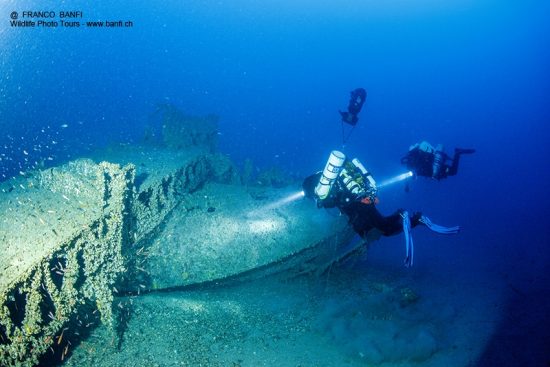
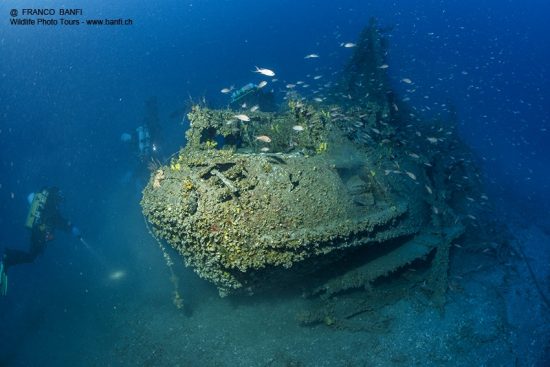
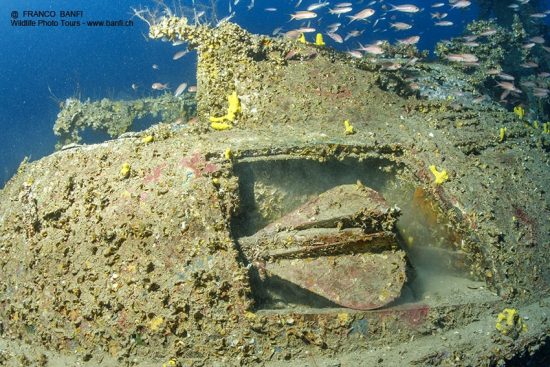

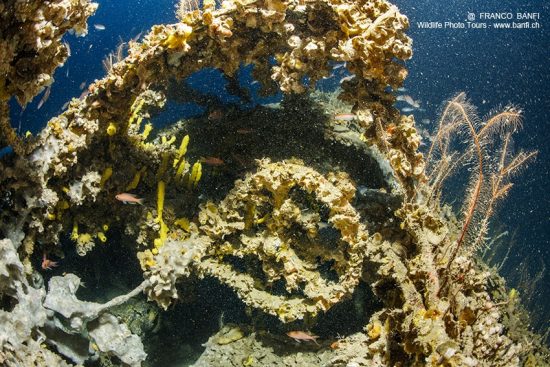
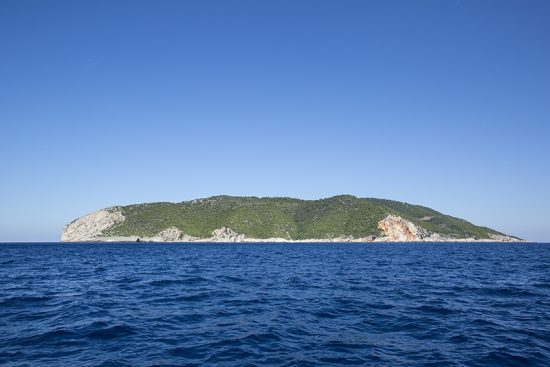
A few weeks ago I reached a special
expedition of professional divers and technicians with the aim of photographing and documenting
the unbelievable discoveries of Lorenz Marovic and his son
Andy. They found the remains of two WWII US Force airplanes and the wreck of the steamship N. Maris, sunk in 1932, close to the islet of Svetac,
Vis archipelago, Croatia.
Lory and Andy equipped their boat
with a heavy, powerful and extremely detailed side-scan sonar, and conducted
hydrographical surveys, primarily scanning the bottom of the Adriatic
Sea. One day, the sonar gave
evidence of something resting on the bottom and some clear “images”, and the
second part of the research involved planning a few technical dives to verify
the results of the sonar.
I met the team of tech divers in Komiza
(Vis Island) to plan the dives in detail.
Due to the relevant depth, between 60 and 110 metres, we chose to dive in a
technical setting, with close circuit rebreathers and bailout tanks, filled
with a different mix of gases (helium, nitrogen and oxygen). This set up
allowed us to stay underwater for a longer period of time with the necessary safety, and
to collect as much information as possible to document and recognize the
wrecks.
We chose to dive to the site
where we saw signals of one airplane’s remains first, resting on the bottom at 95
metres. Looking at the monitor of the sonar, we clearly saw the shape of the
wings and part of the fuselage, and our enthusiasm increased. We could not wait to
plunge to the site, where nobody had ever been before us, to break the silence
of the sea and to surface the memories of the
events which caused the sinking.
The results of that dive are what you see in the
pictures, depicting the wreck of a PBY Catalina aircraft, sunk on the 12th of September
1944 in an attempt to rescue five survivors from very rough sea.
The survivors were the crew of the Consolidated B-24H Liberator #41-28762
Tailwind, assigned to the 515th Bomb Squadron, 376th Bomb Group, Fifteenth Air Force Heavy Bomber
Units, in San Pancrazio (Italy).
On September the 12th, 1944, the crew was scheduled to participate in a raid on Munich, focusing on the Allach BMW Motor Works. That day,
the Munich / Allach engine and the Wasserburg aircraft factories were assaulted
by nearly 330 Boeing B-17 Flying Fortress and Consolidated B-24 heavy bombers,
supported by P-38’s and P-51’s bomb Lechfeld A/F.
In the BMW armament factory, which
manufactured armaments and produced, assembled and repaired aircraft engines
for Junkers, prisoners from the nearby Allach forced labour camp worked. This camp was established on March the 19th 1943 and was the largest sub-camp of the Dachau sub-camp system.
That day, on the return route to San Pancrazio, the rudder
control of the B-24H failed. It dropped out of formation and began a slow left
turn due to a tail flutter. The crew was ordered to bail out and parachuted into
the middle of the Adriatic about 50 miles north of Vis.
An intensive rescue mission was launched and five crew members were picked up
by the PBY Catalina patrol aircraft, which is now resting in the oblivion at 95m deep. Another air rescue
launch found two additional members, while the other four crew members were never found.
Despite high swells and strong winds,
the captain of the PBY Catalina succeeded in doing an open sea landing and taking
aboard the five survivors, but the airplane could not take off. It began to
fill with water and was abandoned to its destiny. Its crew, as well as the
rescued men, were picked up by British Landing Craft Infantry (LCI) , an
amphibious ship, and taken to safety on Vis
island.
The remains of the PBY Catalina are
now a part of the sea, perfectly aligned. Only the lower part is partially
buried in the sandy bottom; the tail and
the structures in plexiglass, together with a few frames, are lost, but most of
the equipment is still easy to recognise, even if the aircraft is totally
covered by encrusting marine life, after having spent 72 years in the Adriatic Sea.
In accordance with Croatian law,
the discovery of the wreck has been declared to the Government and Military
department and it is now forbidden to dive the site. After they have done the
required survey and recovery, it will be open to the public and will be possible
to dive with permits given to diving centres, under the rules of Croatian law.
Taking pictures at 95 metres of
depth is not an easy task, not just because of the photo gear or photographers needing a deep knowledge of technical diving. At 95 metres of depth,
everything bears 10,5 bars of water pressure and everything must be clear in
our mind. Nothing can be improvised : there is no time to be lost in
attempting several settings until finding the good one. The underwater
photographer must have a deep knowledge of technical diving and of the rules of
photography, together with a detailed knowledge of all the photo equipment, dive planning and dive gear.
With a bottom time of only 25
minutes, we did a single dive of 166 minutes, with 130 minutes of decompression
stops at different depths, in order to de-saturate our tissues.
A special thanks to Mares for all
the diving gear, especially the XR Extended Range technical equipment.
 Franco and Sabrina
Franco and Sabrina 2nd December 2016
2nd December 2016 Isola di Sant'Andrea, Sveti Andrija, Croazia
Isola di Sant'Andrea, Sveti Andrija, Croazia 



